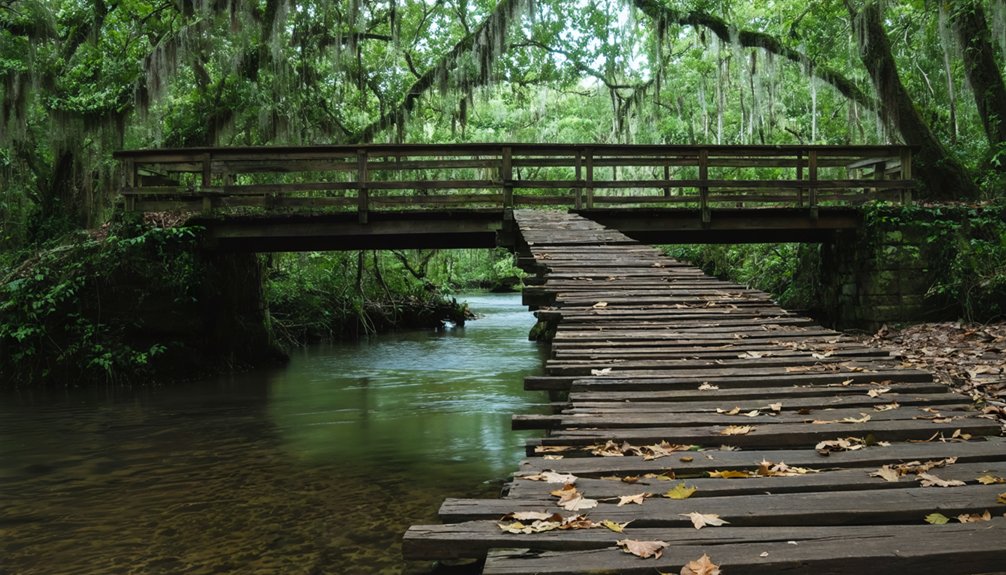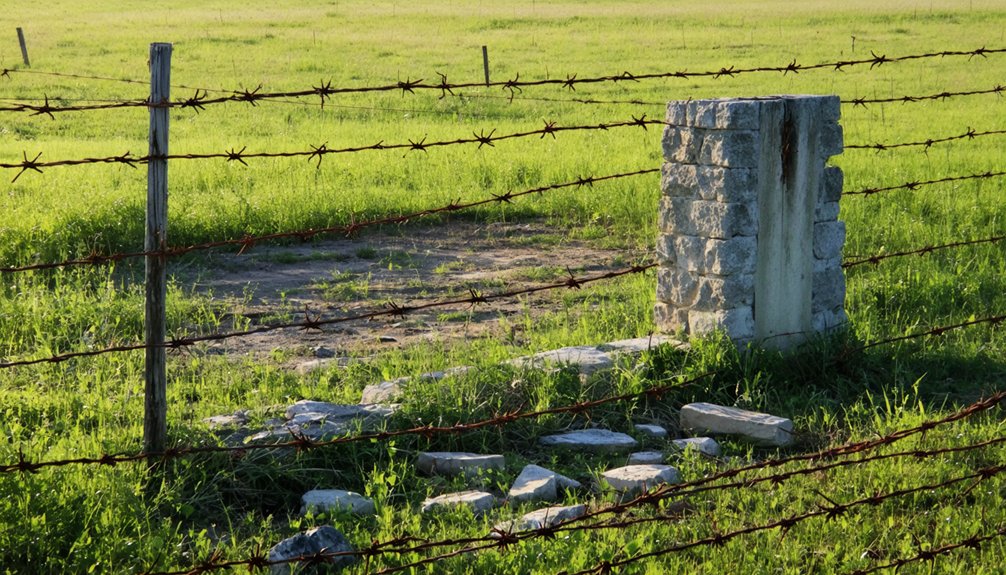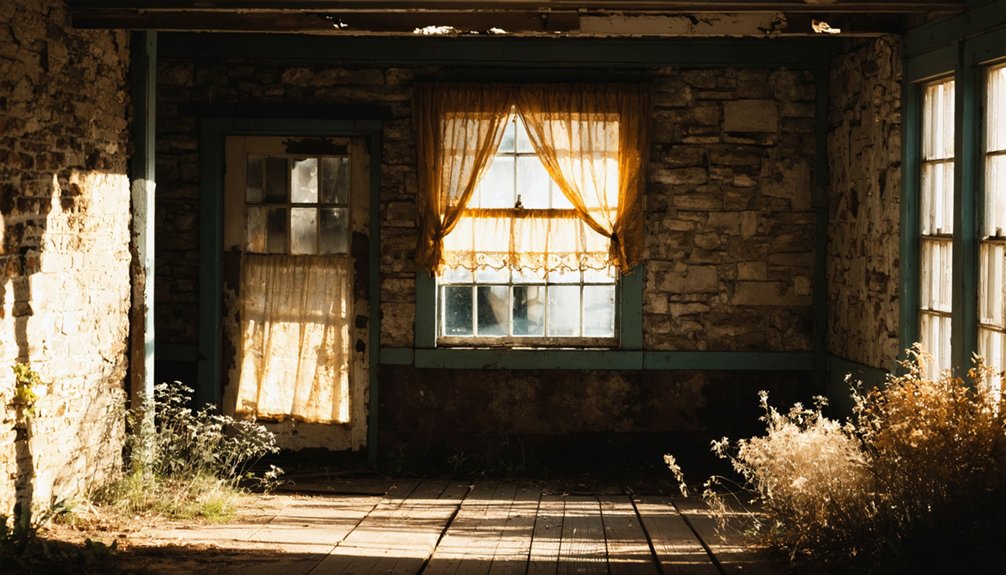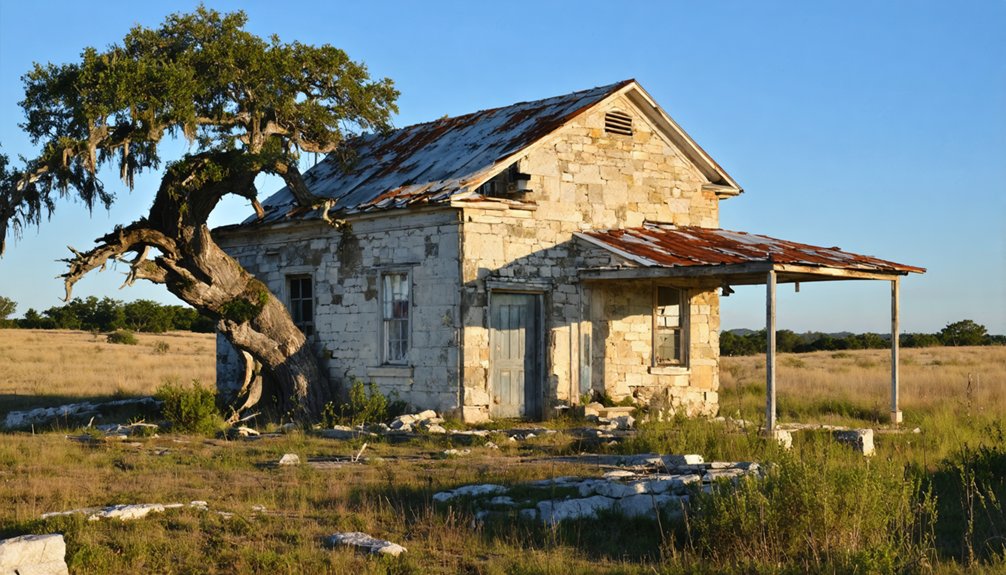You’ll find Block Creek nestled along its namesake waterway in Texas, where pioneer families established a thriving agricultural community in the mid-1800s. The settlement flourished through farming, featuring log cabins, defensive picket fences, and strong community bonds. After railroads bypassed the area and agricultural mechanization took hold, Block Creek gradually transformed into a ghost town. The abandoned site holds fascinating tales, including the mysterious legends of McDow Hole.
Key Takeaways
- Block Creek was established in mid-1800s Texas as a frontier settlement near natural waterways, primarily supporting agricultural communities.
- The community thrived on farming, particularly cotton operations, with notable families like the Blocks and Schmidts leading agricultural development.
- McDow Hole, a local landmark, gained notoriety from tragic 1850s events including unjust hangings and reported supernatural occurrences.
- Economic decline began when major rail lines bypassed the town, leading to business closures and population loss.
- The town’s abandonment was accelerated by agricultural mechanization, droughts, and the closure of essential services like schools and post offices.
Origins and Early Settlement
While Block Creek’s limestone bluffs and natural waterways had long attracted indigenous peoples, permanent settlement of this Kendall County region didn’t begin until the mid-1800s.
You’ll find that Comanche and Lipan Apache tribes originally used these waters for fishing and hunting routes, demonstrating their extensive indigenous knowledge of the terrain.
As pioneer families moved in, they strategically positioned their homesteads near the creek’s life-giving waters.
These early settler interactions with the land mirrored indigenous practices, recognizing the creek’s crucial role for crops and livestock in the arid landscape.
The rugged hill country environment proved challenging, yet the natural corridor provided by Block Creek offered essential resources.
Despite frequent conflicts with Native American raiding parties, settlers persisted in establishing farms and ranches along these limestone-rich banks.
Like many communities that would later become ghost towns, Block Creek’s early prosperity relied heavily on its natural resources and strategic location.
Similar to McDow Hole’s early settlers in Texas, the area held a deep connection to pioneer water sources, which proved vital for survival and development.
Pioneer Life and Community Development
You’ll find that Block Creek’s early settlers established themselves through subsistence farming, clearing dense brush to plant corn and wheat while maintaining small herds of cattle and pigs for sustenance.
Beyond the initial challenges of frontier life, these pioneers forged strong community bonds through shared labor during harvests and barn raisings, often gathering in a central building that served as both church and meeting hall. Much like the historic Polly’s Chapel built in 1882, these structures became the heart of rural Texas communities. Similar to Towash’s mill which ran 24 hours a day, these gathering places fostered both commerce and social connections among settlers.
Your understanding of Block Creek’s development wouldn’t be complete without noting how the settlers’ agricultural success gradually transformed their modest log cabins into more substantial homesteads, marking their shift from survival to stability.
Early Farming Traditions
As pioneers established their presence in Block Creek during the 1830s and 1840s, they brought with them traditional farming practices that would shape the region’s agricultural development for generations.
You’d find these early settlers, like James Smith, practicing diversified agriculture through crop rotation and seasonal planting while managing livestock vital to their survival.
Their farms bustled with activity, from tending chickens and Texas longhorns to maintaining essential blacksmithing operations.
You’ll notice how they strategically constructed their farmsteads, prioritizing barns and corn cribs before expanding their living spaces.
These practical decisions reflected both economic necessity and survival instincts.
The need for defense against threats led many farmers to surround their properties with defensive picket fences.
Early settlers, including the Jourdans, established log-and-board homes that showcased their middle-class standing within the community.
Freedmen farmers, including Jack Dodson, later contributed to these agricultural traditions, maintaining practices that sustained the community despite significant social challenges.
Life Beyond Frontier Hardships
Despite the harsh realities of frontier life, Block Creek’s pioneers forged strong communal bonds through shared experiences and mutual support networks. You’d find families gathering for barn raisings, quilting bees, and harvest celebrations, demonstrating their community resilience through collective action.
Similar to other ghost town communities, life in Block Creek gradually faded as economic opportunities shifted elsewhere. They’d share labor during challenging times, pooling resources to overcome droughts, floods, and harsh winters. Local churches and schools became essential hubs for cultural transmission, where storytelling and religious instruction preserved their heritage. Similar to Thurber’s workers who received once-a-month paychecks, residents adapted to financial hardships by establishing creative payment systems.
You’ll appreciate how they balanced formal education with practical needs – children attended school seasonally while helping with farm duties. Through informal governance and town meetings, they maintained order and self-determination.
Their economic activities diversified beyond farming to include artisan crafts, hunting, and small-scale timber harvesting, creating a more sustainable community.
Agricultural Heritage
You’ll find Block Creek’s agricultural roots deeply embedded in its cotton-growing legacy, which emerged as pioneer families cleared the rugged terrain in the late 1800s.
Much like the historic King Ranch operations, these early farmers diversified their agricultural activities to maintain sustainability through changing market conditions.
Early farming families like the Blocks and Schmidts established productive cotton operations, taking advantage of the region’s fertile soil despite the challenges of Texas weather patterns.
Your understanding of Block Creek’s farming heritage wouldn’t be complete without recognizing how these determined agriculturalists maintained their cotton fields through periods of drought and economic uncertainty, passing their farming traditions down through generations. Similar to early Texas ranchers, they relied heavily on hand-dug norias to supply water to their fields during dry spells.
Cotton Growing Legacy
The cotton growing legacy of Block Creek stands as a tribute to Texas’s agricultural innovation during the late 19th and early 20th centuries.
You’ll find evidence of cotton innovations that transformed the region, from specialized plows breaking thick black sod to the strategic placement of farms near crucial transportation routes.
Like many Texas farming communities, Block Creek’s economic impact was shaped by the introduction of modern farming techniques and the crop-lien system.
You can trace how cotton production expanded across the fertile prairie soil, where farmers could yield up to one bale per acre in prime conditions.
The railroad’s arrival revolutionized market access, though many farmers struggled under the sharecropping system that kept them bound to landowners through commissary credit and cyclical debt.
Early Farming Families
Rich cultural diversity shaped Block Creek’s early farming families, who brought distinct agricultural traditions from their varied origins.
You’ll find their legacy reflected in the innovative ways they adapted to the region’s challenging semi-arid climate and frontier conditions.
These pioneering families faced significant farming challenges while establishing their homesteads:
- Water management became essential as families strategically settled near creeks and springs.
- Family dynamics evolved through knowledge-sharing in agricultural societies.
- Mixed farming methods combined traditional ranching with new crop cultivation.
- Land ownership patterns reflected complex social shifts, especially post-Civil War.
Many of Block Creek’s founding families contributed to more than agriculture – they established churches, schools, and protective structures that formed the backbone of the community.
Their determination to overcome harsh conditions while building lasting agricultural heritage defines Block Creek’s character.
Notable Historical Events
Notable historical events in Block Creek centered around two pivotal periods that shaped the community’s trajectory.
In 1886, the establishment of nearby mining operations brought waves of European immigrants, introducing diverse cultural influences from Poland, Italy, Britain, and Ireland to the region. You’ll find evidence of their presence in the area’s skilled masonry work and cemetery markers.
The second defining period came in the early 20th century when significant economic changes sparked the community’s decline.
You can trace this alteration through abandoned homesteads, where pioneer homes were converted to cattle pens as farming families moved away. The shift from tenant farming to modern agricultural practices elsewhere ultimately led to Block Creek’s transformation into the ghost town you’ll discover today.
The McDow Hole Legends

Among Block Creek’s most chilling narratives stands the legend of McDow Hole, a deep water-filled cavity on Green’s Creek that’s haunted local folklore since the 1850s.
This infamous site gained its reputation through a series of tragic events that unfolded during the frontier era, forever marking it as a place of supernatural occurrences and ghostly apparitions.
The most significant elements of the McDow Hole legend include:
- The discovery of four scalped pioneer bodies near a burning cabin
- The unjust hanging of Charlie Papworth and five others from a pecan tree
- Jenny Papworth’s vengeful spirit appearing with her infant near the water
- Multiple eyewitness accounts of supernatural encounters, including an 1890 incident where a local man fired at Jenny’s apparition
The legend serves as a stark reminder of frontier justice gone wrong and the enduring impact of historical trauma.
Decline and Abandonment
Like many frontier settlements of its era, Block Creek’s decline stemmed from a perfect storm of economic and infrastructural changes in the early 20th century.
When major rail lines bypassed the town, you’d have witnessed the beginning of its economic isolation. Local businesses shuttered as transportation routes shifted, and the community’s lifeblood slowly drained away.
The loss of the town’s post office and school dealt additional blows to community cohesion. As neighboring towns with better rail and road connections flourished, Block Creek experienced steady population decline. Residents moved away seeking opportunities in more accessible locations.
Once-vibrant communities wither when vital services vanish, as residents seek better prospects in more connected towns.
Agricultural mechanization reduced available jobs, while severe droughts made farming increasingly difficult. By mid-century, Block Creek had joined the ranks of Texas ghost towns, its buildings standing as silent witnesses to frontier dreams unfulfilled.
Physical Remnants Today

Today’s visitors to Block Creek encounter a landscape where nature steadily reclaims the remnants of frontier ambition.
The site presents significant preservation challenges, as many structural remains lie hidden beneath vegetation or have succumbed to erosion.
Archaeological findings reveal:
- Scattered foundation stones and building rubble, though most are on private property
- A partially visible street grid, detectable through aerial surveys
- Cemetery plots that have endured despite the town’s abandonment
- Occasional artifacts exposed by seasonal flooding along the creek
You’ll find historical markers providing context for the ghost town’s location, but accessing physical remnants requires permission from landowners.
The creek’s proximity has accelerated deterioration of remaining structures, while natural regeneration continues to obscure traces of this once-thriving settlement.
Regional Historical Significance
While numerous Texas ghost towns share similar narratives of rise and decline, Block Creek’s historical significance stems from its role as a quintessential example of 19th-century frontier settlement patterns.
You’ll find its story reflects broader cultural influences that shaped Texas development, from the strategic placement near natural waterways to the establishment of agricultural communities that formed the backbone of regional commerce.
Block Creek’s evolution through economic shifts mirrors the transformation of rural Texas – from its early reliance on farming and ranching to its eventual decline amid mechanization and changing transportation networks.
Block Creek reflects rural Texas’s broader economic journey, as agricultural communities faded when modern machinery and new transport routes reshaped the frontier.
The community’s journey from a thriving settlement to a ghost town serves as a compelling case study of how technological advances and shifting economic forces reshaped the Texas frontier landscape.
Ghost Stories and Local Folklore

Beyond its historical imprint, Block Creek has earned a haunting reputation through generations of ghostly encounters and supernatural folklore.
You’ll find paranormal investigations centered around McDow Hole, where the ghost of Jenny Papworth clutches her baby, and throughout the abandoned buildings where the mysterious “Top Hat Man” roams Block Creek’s shadowy corners.
The area’s supernatural legacy manifests in four distinct ways:
- Residual hauntings near water sources, especially Green’s Creek
- Unexplained cold spots and whispers in historic structures
- Apparitions tied to violent deaths and unfinished business
- The “lady in white” phenomenon, connecting Block Creek to broader Texas ghost lore
These tales don’t just entertain – they preserve the community’s memory through shared experiences, drawing curious visitors who seek to uncover Block Creek’s spectral secrets.
Frequently Asked Questions
What Native Plants and Wildlife Were Common in Block Creek’s Early Days?
You’d find rich native flora like mesquite, live oak, and bluebonnets, plus incredible wildlife diversity including white-tailed deer, wild turkeys, and hawks soaring above Block Creek’s pristine waters.
How Did Block Creek Residents Get Medical Care in the 1800S?
You’d rely on traveling doctors, midwives, and traditional healers for basic medical practices. When serious health challenges arose, you’d use home remedies or make the difficult journey to larger towns.
Were There Any Significant Weather Events That Impacted Block Creek?
You’ll find evidence of devastating flood impacts during major Hill Country storms, particularly in 1987 and 2002, while severe drought effects plagued the region’s water resources throughout the early 2010s.
What Trading Routes or Stagecoach Lines Passed Through Block Creek?
Like a web of frontier freedom, you’ll find Block Creek’s trading history intertwined with the San Antonio-Fredericksburg Road and military stage routes, running 10 miles north through Grapetown’s relay station.
Did Block Creek Have Its Own School or Church Buildings?
You won’t find any documented school history or church architecture in this location. Historical records don’t show evidence of either type of building existing there during its brief existence.
References
- https://www.themoonlitroad.com/mcdow-hole-texas-ghost-story-haunted/
- https://www.ghosttowns.com/states/tx/tx_ghst_twns_sect1345.doc
- https://texashighways.com/travel-news/four-texas-ghost-towns/
- https://en.wikipedia.org/wiki/List_of_ghost_towns_in_Texas
- https://www.wilcotx.gov/1635/Historical-Abandoned-Towns
- https://www.tshaonline.org/handbook/entries/block-creek
- https://www.youtube.com/watch?v=Zd8-gKw-5Hc
- https://freepages.history.rootsweb.com/~gtusa/usa/tx.htm
- https://www.tshaonline.org/handbook/entries/block-creek-tx
- https://www.backroadstexas.net/the-tale-of-the-hill-countrys-historic-polly-texas/



